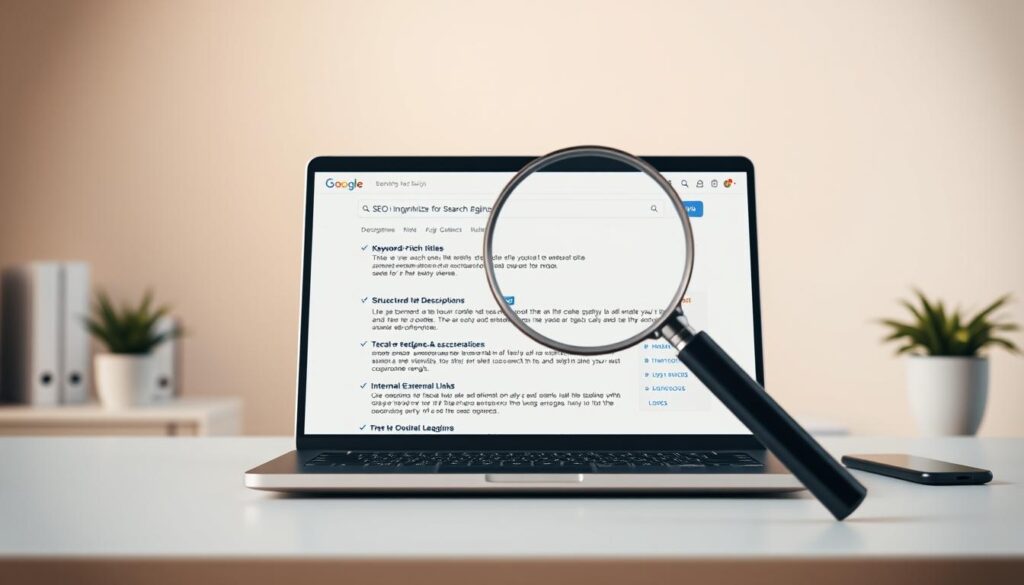Are you struggling to get your website noticed online? With millions of websites competing for attention, it’s easy to get lost in the noise.
Can a simple tweak to your website’s content really boost its search engine ranking? Yes, it can. And it’s vital for any online business to grasp the importance of Search Engine Optimization (SEO).
Getting to know SEO is essential to make your content seen by users. By optimizing your site, you help search engines understand your content. This makes it more likely to show up in search results.
With the right website SEO tips, you can greatly enhance your online presence. This will also drive more traffic to your site.
Understanding SEO and Its Importance

As the internet grows, SEO’s role in boosting website visibility and organic traffic is vital. SEO focuses on improving user experience. It involves optimizing for keywords, making sites easy to use, and sharing valuable content. This approach aims to engage and inform your audience, not just please algorithms.
What is SEO?
SEO stands for Search Engine Optimization. It’s about making your website more visible in search engine results. It’s a field that keeps evolving, requiring knowledge of search engines, user searches, and keywords.
Effective SEO combines strategies like keyword research, on-page optimization, and link building. By following SEO best practices, businesses can boost their online presence. This can lead to more organic traffic and higher conversion rates.
Why SEO Matters for Your Business
In today’s digital world, having a website is just the start. With so many websites out there, SEO is key to standing out. Optimizing your site for search engines can increase your online visibility. This helps you reach more customers and stay competitive.
- Enhance website visibility
- Increase organic traffic
- Improve brand credibility
- Support content marketing efforts
Key SEO Metrics to Monitor
Tracking key metrics is vital to measure your SEO success. These include organic traffic, keyword rankings, click-through rates (CTR), and conversion rates. By analyzing these, you can spot areas for improvement and tweak your SEO strategy.
- Organic traffic: The number of visitors coming from search engines.
- Keyword rankings: Your position in search engine results for target keywords.
- CTR: The percentage of users clicking on your website in search results.
By focusing on these metrics and refining your SEO strategy, you can enhance your website’s performance. This will help you achieve your business goals.
Keyword Research: The Foundation of SEO

Finding and studying the right keywords is key to making your website more visible online. Knowing what terms your audience looks for helps you create content they’ll find useful. This boosts your site’s SEO.
Tools for Effective Keyword Research
Many tools can help with keyword research. Google Keyword Planner shows search volume and competition. Ahrefs and SEMrush offer deeper insights, like competitor strategies and content gaps.
- Google Keyword Planner
- Ahrefs
- SEMrush
Long-Tail vs. Short-Tail Keywords
It’s important to know the difference between long-tail and short-tail keywords. Short-tail keywords are short and broad, with lots of competition. Long-tail keywords are specific and have less competition, making them easier to rank for.
- Short-tail keywords: High competition, broad terms
- Long-tail keywords: Lower competition, specific phrases
Analyzing Keyword Competition
Looking at keyword competition means seeing how hard it is to rank for a keyword. Tools like Ahrefs give a Keyword Difficulty Score. This score helps you choose keywords based on how competitive they are.
By doing deep keyword research and understanding the competition, you can create SEO strategies that match your audience’s search habits. This improves your website’s visibility and brings more targeted visitors to your site.
Optimizing On-Page SEO

Improving your website’s on-page SEO is key to better search rankings and more visitors. On-page SEO makes each web page rank higher and attract more relevant traffic.
Title Tags and Meta Descriptions
Title tags are very important for on-page SEO. They should be short, descriptive, and include the main keyword. A good title tag can boost click-through rates from search results.
Meta descriptions are not a direct ranking factor but are vital for getting users to click on your site. They should be engaging, informative, and include the target keyword to boost relevance.
Header Tags and Content Structure
Using header tags (H1, H2, H3, etc.) makes content easier to read and helps search engines understand your page’s structure. The H1 tag should have the main title and the primary keyword.
A clear content structure improves user experience and helps search engines index your content better.
Image Optimization Techniques
Optimizing images is a key but often forgotten part of on-page SEO. Use descriptive file names with target keywords and add alt text to improve site accessibility and search rankings.
Also, compressing images to reduce file size without losing quality can speed up page loading. This is good for both user experience and SEO.
The Role of Quality Content in SEO
Creating content that speaks to your audience is key to bettering your website’s SEO. Quality content not only keeps users interested but also boosts your site’s ranking. We’ll dive into why quality content matters in SEO and share tips on making and keeping valuable content.
Creating Engaging and Valuable Content
To make content that grabs attention, aim to be informative, well-structured, and easy to use. Your content should meet your audience’s needs and answer their questions. Do thorough research to know what your audience wants and shape your content to fit.
High-quality content has several key features:
- Clear and simple language
- Right use of header tags (H1, H2, H3, etc.)
- Relevant keywords
- Engaging visuals like images, infographics, and videos
Updating Existing Content
Keeping your content fresh is vital for its relevance and SEO. Regularly check your content to make sure it’s current and correct. This means not just updating old posts but also adding more to them.
Here’s what to do when updating content:
- Update old info
- Add new insights or data
- Make it easier to read and organize
- Follow the latest SEO best practices
Content Formats That Boost SEO
Different content types can really help your SEO. Try out various formats to see what your audience likes best.
Some great content formats include:
- Blog posts
- Videos
- Infographics
- Podcasts
- E-books and whitepapers
By using these formats, you can boost user engagement and make your website more visible on search engines.
Building a Strong Backlink Profile
A strong backlink profile is key to a successful SEO strategy. It boosts your website’s credibility and authority. Off-page SEO, like link building and social media marketing, is essential for this.
What Is a Backlink?
A backlink is a link from one website to another. It’s like a vote of confidence in the content or service of the linked site. Quality backlinks are vital because they show search engines your content is valuable and relevant.
How to Earn Quality Backlinks
Earning quality backlinks needs a strategic plan. Here are some effective methods:
- Create high-quality, engaging content that others will want to link to.
- Participate in guest blogging to build relationships with other websites in your niche.
- Utilize broken link building by finding broken links on other sites and replacing them with your content.
- Leverage resource pages by listing your website on relevant resource lists.
Avoiding Toxic Backlinks
Not all backlinks are good; some can harm your ranking. To avoid toxic backlinks, regularly check your backlink profile and:
- Identify and disavow harmful links using tools like Google Search Console.
- Regularly audit your backlinks to ensure they are from reputable sources.
- Use link detox tools to identify toxic links.
By focusing on building a strong backlink profile and avoiding toxic backlinks, you can greatly boost your website’s ranking and improve your SEO performance.
The Importance of Technical SEO
Technical SEO is key for better search rankings and user experience. It involves making a website’s backend better. This makes it easier for search engines to find and index it.
Improving Site Speed and Performance
Site Speed and Performance
Site speed is very important for both users and search engines. A slow site can cause people to leave quickly.
To make your site faster, try optimizing images and using browser caching. Optimizing images makes them smaller and speeds up loading times.
Mobile Responsiveness
Most people use mobile devices to surf the web. So, mobile responsiveness is very important for SEO.
A site that works well on mobile devices is easy to use on any screen size. To make your site mobile-friendly, use flexible designs and media queries.
XML Sitemaps and Robots.txt
XML sitemaps and robots.txt files help search engines understand your site.
An XML sitemap lists all your site’s URLs, helping search engines find and index them. The robots.txt file tells crawlers which pages to visit or skip.
By working on these technical SEO areas, you can boost your site’s search rankings and improve user experience.
Local SEO Strategies for Businesses
Local SEO is key for businesses wanting to show up in local search results. It helps them get more local customers and boost their sales.
Why Local SEO is Crucial
Local SEO is a must for businesses in specific areas. It makes them visible when local people search for what they offer. This can bring in more people, calls, and sales.
Also, local SEO is cheaper than old-school ads. It targets people already looking for what you offer. This means lower costs and better ROI.
Google My Business and Its Benefits
Optimizing your Google My Business listing is a top local SEO tactic. Google My Business lets businesses manage their online presence on Google. It helps them show up in local searches and share important info like hours and contact details.
To make the most of Google My Business, keep your info current and add good photos. Also, answer customer reviews fast. This shows you care about your customers and can help your reputation.
Local Citations and Reviews
Local citations and reviews are also key for local SEO. Local citations are mentions of your business on other sites, like directories. They help you show up in local searches and build trust.
Customer reviews are also important. They show others what to expect. Encourage people to review you on Google My Business and other sites. Always respond to reviews, good or bad, to show you value your customers.
User Experience (UX) and SEO
A well-designed user experience can greatly improve a website’s SEO. This leads to more traffic and better search engine rankings. Search engines like Google value websites that are easy to use.
UX and SEO are closely linked. A user-friendly site keeps visitors engaged, reducing bounce rates. Search engines see this as a sign of a website’s quality, boosting its SEO.
The Connection Between UX and SEO
The bond between UX and SEO comes from how users interact with a site. Key factors like page speed, mobile friendliness, and navigation ease are vital for user satisfaction.
- Page Loading Speed: A quick site improves user experience and search engine rankings.
- Mobile Responsiveness: Most users access sites on mobiles, so a responsive design is key.
- Ease of Navigation: Easy navigation helps users find what they need quickly, making their experience better.
As Google’s guidelines state, a site that works well on all devices will rank higher in search results.
Creating a User-Friendly Website
To make a user-friendly site, focus on several important elements:
- Clear Layout: A clean design that directs the user’s focus to important content.
- Consistent Design: Uniform design elements like typography, colors, and button styles.
- Accessible Content: Content that’s easy to read and understand, avoiding hard terms.
By focusing on these, sites can boost user engagement and SEO.
Importance of Website Navigation
Good website navigation is key for both users and search engines. It helps in:
- Discovering Content: Easy navigation lets users find what they need, keeping them on the site longer.
- Indexing Pages: Clear navigation helps search engines crawl and index pages better.
“A website’s user experience is a key determinant of its SEO success. By prioritizing UX, businesses can improve their search engine rankings and drive more traffic to their site.”
By applying UX principles, businesses can greatly enhance their SEO. This leads to better search engine rankings and more online visibility.
Leveraging Social Media for SEO
Using social media can make your website more visible and reach more people. Social media is not just for chatting; it’s a treasure trove for SEO. Good social media use can bring a lot of organic traffic to your site, boosting your digital marketing plan.
How Social Media Impacts SEO
Social media affects SEO in many ways. It boosts your online presence, making your brand easier to find. Social signals, like likes and shares, can help your search rankings. Even though the exact effect of social signals is up for debate, a strong social media presence can increase traffic and get you backlinks.
- Improved brand visibility
- Increased website traffic
- Potential for generating high-quality backlinks
Best Practices for Social Sharing
To get the most out of social media for SEO, follow some key practices. Creating content that people want to share is essential. This can be informative blog posts, engaging videos, or eye-catching infographics. Make sure your content fits each platform well, using the right hashtags and descriptions.
- Optimize your content for each platform
- Use relevant hashtags to increase discoverability
- Engage with your audience by responding to comments and messages
Engaging Your Audience Online
It’s important to interact with your audience online to build a loyal following. Use social media to talk to your audience, share content made by others, and run contests. Building a community around your brand can boost loyalty and encourage sharing.
To improve your social media strategy, consider these tips:
- Share behind-the-scenes content to give your audience a glimpse into your brand
- Use Instagram Stories and Facebook Live to connect with your audience live
- Keep an eye on your social media analytics to see what content works best
By using social media wisely, you can make your website more visible, attract more visitors, and help your SEO. Adding social media to your SEO plan is now a must to stay ahead in the digital world.
Tracking and Analyzing SEO Performance
Tracking SEO performance is more than just looking at numbers. It’s about getting insights to boost your online presence. In the fast-changing world of SEO, knowing how your site performs is key to making smart choices.
Tools for Measuring SEO Success
To track SEO performance well, you need the right tools. Google Analytics, SEMrush, and Ahrefs are among the top choices. They give you deep insights into your site’s traffic, keyword rankings, and backlinks.
With these tools, you can keep an eye on important metrics like organic traffic, bounce rates, and conversion rates. This info is gold for seeing how your SEO efforts affect your site’s visibility and engagement.
Interpreting Analytics Data
Getting data is just the start; understanding it is where the real value is. When you analyze your SEO data, look for trends and patterns. For example, a sudden rise in organic traffic after updating content might show your new content is hitting the mark.
It’s also key to understand the story behind the numbers. A high bounce rate doesn’t always mean bad news. It could mean your content is so spot-on that visitors find what they need fast and don’t need to look around more.
Adjusting Your Strategy Based on Data
The main goal of tracking and analyzing SEO performance is to shape your strategy and make decisions based on data. Based on your analytics, you might need to tweak your keyword focus, boost content quality, or enhance user experience.
- Spot areas for improvement and focus on actions with the biggest impact.
- Try out different SEO strategies and see how they work.
- Keep a close eye on your KPIs to make sure your changes are working.
By using a data-driven approach to SEO, you can fine-tune your strategies, climb the search engine rankings, and bring more traffic and conversions to your site.
Staying Updated with SEO Trends
To stay ahead in digital marketing, keeping up with SEO trends is key. Follow industry leaders and blogs to learn about the latest SEO best practices and new strategies.
Industry Insights and Algorithm Updates
Following leaders like Moz, Ahrefs, and SEMrush can give you valuable insights. They help you understand how to improve your website’s ranking. Knowing about algorithm changes is also important, as they can greatly impact your site’s visibility.
Adapting to Change
SEO requires constant learning and adapting. By keeping up with new digital marketing strategies, you can make sure your website stays competitive. This helps attract more organic traffic to your site.